4 AI / ML and Agriculture and Food Industries [Nichols, Hood, Sincavage]
LEARNING OUTCOMES
AI in the Agricultural (Ag) and food industries comprise a number of technologies, from robotics to machine learning. By “AI” we are simply referring to machinery and technologies used to conduct complex tasks that previously required human thought to complete. Our purposes:
- To explore artificial intelligence (AI) and Machine Learning (ML) in the world of agriculture, food production and global food supply.
- To investigate AI related technologies from space operations to earth manufacturing with the goal of feeding the world population more efficiently.
- To recognize the US will continue to be vulnerable to deliberate introductions of exotic plant and animal diseases by terrorist groups and to identify effects.
INTRODUCTION
In 2023, Artificial Intelligence (AI) is the subject of thousands of articles and books. Artificial intelligence is defined as: “1. a branch of computer science dealing with the simulation of intelligent behavior in computers, and 2: the capability of a machine to imitate intelligent human behavior.” (Definition of Artificial Intelligence , 2023). Chapter 4 is devoted / limited to continuing our humanitarian goal of using technologies to improve the lives of the global population. In our previous textbook, Space Systems: Emerging Technologies and Operations(Nichols R. K., et al., 2022), Section III included three chapters on the subject. Chapter 10 covered Drones and Precision Agricultural Mapping. (Mumm, 2022) Chapter 11 covered Civilian use of Space for Environmental, Wildlife Tracking, & Fire Risk Zone ID. (Ryan, 2022) Chapter 12 addressed the Humanitarian Use of Space Technologies to Improve Global Food Supply & Cattle Management. (Larson, 2022)
“SECTION 3 is our Hope for Humanity and Positive Global Change. Just think if the technologies we discuss, when put into responsible hands, could increase food production by 1-2%. How many more millions of families could have food on their tables?” (Nichols R. K., et al., 2022)[1]
ARTIFICIAL INTELLIGENCE AND AGRICULTURE: HOW INTELLIGENT TECHNOLOGIES CAN HELP FEED THE WORLD
AI has significant potential to improve the agricultural industry and help feed the worlds growing population. Through applications like precision agriculture, livestock monitoring, supply chain optimization, and labor optimization, AI can provide farmers with essential information and insights to make better decisions about productivity. (Zheng, 2023)
However, there are challenges that must be addressed in the adoption of AI (and ML) in Agriculture (Ag) such as: data availability and quality, integration with legacy systems, and cost. Ethical considerations of transparency, accountability, fairness, and privacy must be integrated into the AI systems implemented.
There is also the threat of using AI to implement Bioweapons in the Ag sphere and necessity of risk assessments to reduce vulnerabilities from these threats and to apply appropriate countermeasures. (Nichols & Carter, 2022) (Nichols R. K., et al., 2022)
TYPES OF ARTIFICIAL INTELLIGENCE
AI dates back to the 1950’s with rule-based systems. In recent years, sophisticated AI algorithms capable of complex decision-making and problem-solving tasks have been built. AI takes many forms:
Rule-based AI: aka expert systems, uses pre-programmed data and rules and relies on “if-then” statements and logical rules to make decisions.
ML: a form of AI that involves developing algorithms that can learn from data and improve performance over time.
Deep Learning: ML subset that focuses on neural networks with many layers of processing. They are used to analyze “big data,” or large amounts of data, image recognition, speech recognition, and natural language processing.
Reinforcement Learning: see definition below.
Natural Language Processing (NLP): is a type of AI involving analyzing and generating human language. NLP is used in chatbots, voice assistants, and language translations.
Reactive Machines: Only respond to specific stimuli and do not learn or predict outcomes
Limited Memory: Limited to specific data sets are able to learn to improve performance
Self-Aware: Theoretical and would possess human-like consciousness and emotions.[2] (Zheng, 2023)
Similarly, there are growth in the machine learning (ML) techniques:
Supervised Learning: Training an AI system with labeled data sets and allowing it to make predictions,
Unsupervised Learning: Training an AI system on unlabeled data sets and enabling them to identify patterns and relationships without guidance,
Reinforcement Learning: Training an AI system through trial and error, rewarding it for correct decisions and punishing it for incorrect ones. (Zheng, 2023)
AG LANDSCAPE
The global landscape of agriculture is diverse and complex with different regions and countries facing unique challenges and opportunities. (Zheng, 2023) identifies key global trends in the Ag and food production.
Growing population and food demand: Global population is projected to reach 9.7 billion by 2050, leading to a significant increase in global food demand. (Zheng, 2023)
Climate change and environmental pressures: Climate change and environmental pressures pose significant challenges for agricultural production. More frequent and severe weather events such as droughts and floods can affect crop yields and increase production costs. “The agriculture industry needs to adopt sustainable practices to minimize its environmental footprint.” (Zheng, 2023)[3] See (Wrightstone, 2017) and (R. K. Nichols, 2021)also for different perspectives.
Technical advancements in Ag: we have come a long way from simple tools and plows to advanced machinery like tractors and combines. Now AI offers the next generational step to improve efficiency, productivity, and sustainability in Ag. (Zheng, 2023)
Changes in Crops and Livestock production: Resources, cultural practices, cultivation readiness affect the high-value crops such as rice, wheat, fruits, and vegetables all may change with the AI use. Similarly, livestock production including dairy, meat, and poultry will be directly affected by AI. (Zheng, 2023) Land ownership will change, and this has an indirect affect on the introduction if AI technologies. [4]
Supply chain and distribution: Ag supply chains comprise a network of producers, processors, distributors, wholesalers, and retailers who collectively ensure that food reaches consumers. Logistics and distribution play a critical role in maintaining the quality and safety of food products during transportation. (Zheng, 2023)
Policy and Regulation: policies, regulations, environmental practices, food safety inspections, labor standards can vary significantly from country to country and may have significant implications for the industry’s sustainability and profitability. (Zheng, 2023)
SURVEYING THE POTENTIAL OF AI IN AGRICULTURE
A good place to start is a review of Louis Columbus’ Forbes article on the 10 Ways AI Has The Potential To Improve Agriculture In 2021. [5] (Columbus, 2021) We follow this review with a report on Dr. MingHai Zheng’s 2023 book entitled Artificial Intelligence and Agriculture: How Intelligent Technologies Can Help Feed the World. Dr. Zheng explores the current state-of-the-art intersection of AI and agriculture, focusing on how intelligent technologies can be used to improve farming practices and increase productivity. Dr Zheng’s goal is to identify opportunities for future research and development. Along with Hope comes Evil. Our survey will include selected directions from our own research chaired by international SME Dr. Suzanne M. Sincavage in her Chapter 8. Bio-threats to Agriculture-Solutions from Space. (S. Sincavage, 2022)
AI POTENTIAL TO IMPROVE AGRICULTURE
The driving force is money. According to BI Intelligence Research, global spending on smart, connected agricultural technologies and systems, including AI and machine learning (ML) is projected to triple in revenue by 2025 to $15.3 billion. (Top 5 2023 Agriculture Trends to Watch, 2023). (Columbus, 2021) Spending on AI solutions for agriculture is predicted to grow at a whopping CAGR[6] of 25.5% to $4 billion in 2026. (Columbus, 2021) 87% of U.S. agricultural businesses use AI. (87-of-us-agriculture-businesses-are-currently-using-ai, 2021) According to Allied Market Research, IoT enabled agricultural (IoTAg) monitoring is the fastest connected growing technology segment projected to reach $84.5 billion by 2031 growing at CAGR of 12.6%. (Allied Market Research, 2023) How valid these estimates are only time will tell, however, we conclude there is considerable financial interest in AI/ ML and real-time sensor data to apply to agricultural applications, such as precision farming, livestock monitoring, [7] smart greenhouses, and fish farm monitoring.
AI, machine learning (ML) and the IoT sensors that provide real-time data for algorithms increase agricultural efficiencies, improve crop yields, and reduce food production costs. (Columbus, 2021)Of special interest is IoT- enabled sensors and devices that allow farmers to remotely monitor soil moisture, temperature, and other conditions to optimize crop yields and reduce water usage. (Allied Market Research, 2023)
Linking farms through a single platform and sharing intelligence gained is another method to improving productivity and reducing waste. Allied Market Research, 2023)
IoT boosts agricultural output. Real time field data collection, storage, analysis, and control platforms improve operational efficiency and increase crop yields. Excellent data portends the success of crop cycles. (Columbus, 2021) Think of the many processes that farmers must track weather, seasonal sunlight, migratory patterns of animals, birds, insects, deer,[8] use of specialized fertilizers, insecticides by crop, planting cycles and irrigation cycles all affect yield. These are perfect for AI and ML solutions. Data-centric approaches work. (Columbus, 2021)
SURVEILLANCE
Using AI and ML- based surveillance systems to monitor every crop field’s real-time video feeds identifies animal or human breaches, sending an alarm or alert immediately can be remarkably effective, annoying [9] and provide evidence, if necessary, in a police call. On the positive side, AI / ML reduce domestic and wild animals potential to accidentally destroy crops or experience a break-in or burglary at a remote farm location. Farm perimeter security can be augmented. AI /ML solutions are scalable. (Columbus, 2021)
CROP YIELD PREDICTION
Crop yield predictions are improved through real-time AI/ML sensor data and visual analytics data from drones. (Larson, 2022) Drones provide real-time streaming on large acreage via “Earth Traces.” These make it possible to combine in-ground sensor data on moisture, fertilizer, and natural nutrient levels plus water / irrigation availability to analyze growth patterns of each crop over time. (Nichols R. K., et al., 2022) (Columbus, 2021) Understanding yield rates and quality levels of crops help agricultural firms, co-ops and farmers better negotiate for the best possible price for their harvests. (Columbus, 2021)
YIELD MAPPING
“Yield mapping is an agricultural technique that relies on supervised machine learning algorithms to find patterns in large-scale data sets and understand the orthogonality of them in real-time – all of which is invaluable for crop planning.” (Columbus, 2021) Potential yield rates of a given crop field can be estimated before a vegetation cycle is started. Some of the techniques deployed are ML, 3-Dmapping, social condition data from IoT sensors and drone-based data on soil-color. (Ryan, 2022) (Columbus, 2021) (See Figure 4-1 example Integration.)
Figure 4-1 Integrate UAV Technology with Yield Maps
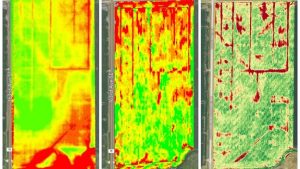
Source: (Integrate UAV Technology with Yield Maps, 2023)
DRONES AND PESTS
The UN, international agencies, and large-scale agricultural operations (and Kansas State University)[10] are pioneering drone data combined with in-ground sensors (and weather stations) [11]to improve pest management. (Mumm, 2022) Drones using IR camera data combined with sensors on fields and weather data, which monitor plants’ health, permit prediction and identification of pest infestations. (Mumm, 2022) (Columbus, 2021) (Figure 4-2)
Figure 4-2 (a) State-of-the-art open-loop remote sensing paradigm and (b) closed-loop IPM paradigm envisioned in this article. Sensing drones could be used for detection of pest hotspots, while actuation drones could be used for precision distribution of solutions.
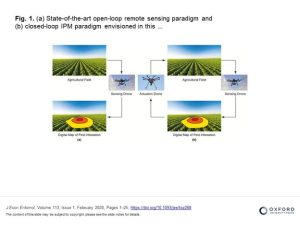
Source: Adapted from (Teske A. L., 2019)
Both (Mumm, 2022) and (Columbus, 2021) point out that AI/ML optimization biodegradable pesticides to only the field areas that need treatment, reduces costs, and increases yields. By using intelligent sensors combined with visual data streams from drones, agricultural AI applications can now detect a planting area’s most infected areas. Using supervised machine learning algorithms, they can then define the optimal mix of pesticides to reduce pests’ threat spreading further and infecting healthy crops.
FARM EMPLOYEE TROUBLE? AI TO RESCUE
In 2023, there’s a shortage of agricultural workers, making AI and machine learning-based smart tractors, agribots and robotics a viable option for many remote agricultural operations. Large farming operations turn to robotics for hundreds of acres of crops while also providing an element of security around the perimeter of remote locations. Programming self-propelled robotics machinery to distribute fertilizer on each row of crops helps keep operating costs down and improve field yields. (Columbus, 2021)
TRACK AND TRACEABILITY (T&T)
Improving the track-and-traceability of agricultural supply chains by removing roadblocks to get fresher, safer crops to market is a must-have Tin 2023. A well-managed T&T system helps reduce inventory shrinkage by providing greater visibility and control across supply chains. A state-of-the-art T&T system can differentiate between inbound shipments’ batch, lot, and container level assignments of materials. T&T systems rely on advanced sensors to gain greater knowledge of each shipment’s condition. RFID and IoT sensors are now becoming more commonplace across manufacturing. (Columbus, 2021)
WATER
AI/ML optimizing irrigation systems and measuring how effective frequent crop irrigation improves yield rates are all areas AI contributes to improving farming efficiencies. Water is the scarcest resource in many parts of North America, especially in communities that rely most on agriculture as their core business. Being efficient in using it can mean the difference between a farm or agricultural operation staying profitable or not. (Columbus, 2021) (Larson, 2022) (Mumm, 2022) (Ryan, 2022)
LIVESTOCK
(Larson, 2022) discusses monitoring cattle health and food intake. Dr Larson validates (Columbus, 2021) conclusions about livestock in his Forbes article. “Monitoring livestock’s health, including vital signs, daily activity levels and food intake, ensures their health is one of the fastest-growing aspects of AI and machine learning in agriculture. Understanding how every type of livestock reacts to diet and boarding conditions is invaluable in understanding how they can be best treated for the long term. Using AI and machine learning to understand what keeps daily cows content and happy, producing more milk is essential. For many farms who rely on cows and livestock, this area opens up entirely new insights into how farms can be more profitable.” (Columbus, 2021)
ROBOTS AND AI
According to research by the University of Sydney, Ag-robots have the potential to mitigate food security issues.[12] (University of Sydney, 2022) Ending global hunger has long been a critical goal for the global community. When the United Nations’ Sustainable Development Goals were released in 2014, ending hunger, food insecurity and all forms of malnutrition formed SDG2. (University of Sydney, 2022)
“Though there has been some progress in the fight against hunger – ongoing conflicts, economic downturns and the COVID-19 pandemic have been major barriers to achieving SDG2. As of 2020, according to the UN, 720 and 811 million people globally faced hunger, and current estimates suggest that 660 million people may still face hunger in 2030.” (University of Sydney, 2022)
Professor Salah Sukkarieh, a robotics engineer at the University of Sydney’s Australian Centre for Field Robotics, and his team have developed Digital Farmhand, a small, autonomous, electric tractor-like vehicle can assist smallholder farmers to improve their productivity and yields.
“Our Digital Farmhand robot is designed to assist smallholder farmers to improve their productivity and yields and provide a more reliable income amidst changing markets and climates. In its simplest form the Digital Farmhand is a small, autonomous electric tractor-like vehicle that can tow a variety of implements such as seeders, weeders, and bed preparation tools, and can undertake precision automation of many labor-intensive farm tasks, like weeding, spraying, and seeding.” (University of Sydney, 2017)
“Digital Farmhand can also use accessible smartphone technologies along with AI to provide crop analytics such as yield estimation or pest and disease identification.” (University of Sydney, 2022) Professor Sukkarieh’s team is developing open-source artificial intelligence packages for smartphones which can be easily accessed in the APAC. (University of Sydney, 2017) [13]
Figure 4-3 Digital Farmland
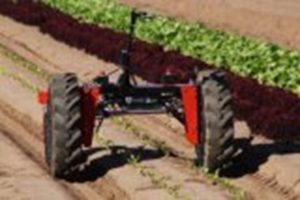
Source: http://confluence.acfr.usyd.edu.au/display/AGPub/Our+Robots ( (University of Sydney, 2017)9
5 WAYS AI IMPROVES FOOD MANUFACTURING
Aptean is a large food service technology organization. Aptean presents 5 ways that they predict that AI will change food manufacturing for the better.
- Developing New Recipes Guided By Consumer Trends
According to Aptean’s VP John Payne, “all food manufacturers know that they must constantly be on the lookout for new ways to refresh their product lines in order to stay relevant and tap into new sources of revenue. Whereas this has traditionally taken the form of surveys and adapting to emerging trends, AI offers companies the opportunity to predict their customers’ preferences.
By analyzing huge amounts of data around sales patterns and flavor preferences for each demographic group, manufacturers are now able to model future trends and develop new products to capitalize on them quicker. AI is also being used to allow consumers a greater degree of personalization in the products they buy. This breakthrough doesn’t just identify what the most popular flavor combinations are likely to be, it makes the product development process shorter and less expensive, helping companies get their new products to market faster and with less trial and error.” (Payne, 2021)
- Supply Chain Management
Being able to manage supply chains effectively is one of the top priorities for food manufacturers. Companies at the cutting edge are now utilizing algorithms based on artificial neural networks to monitor shipments at every stage of the supply chain, improving food safety standards and enabling full transparency. AI in the food industry is also capable of creating accurate forecasts to manage inventory and pricing. This kind of predictive analysis helps keep food businesses one step ahead, enabling them to avoid wastage and unnecessary costs, said Mr. Payne. (Payne, 2021)
- A More Efficient Cleaning Process
All equipment and machinery involved in food production needs to be cleaned to the most rigorous standards. This isn’t just to avoid contamination of food with pathogens, but to prevent allergen cross-contamination. Unfortunately, this comes at a cost—in terms of both time and money. Innovative AI technology is beginning to change this. Developed by the University of Nottingham, a Self-Optimizing-Clean-In-Place (SOCIP) system uses optical fluorescence imaging and ultrasonic sensing to scan the food remains left in machinery after use. (University of Nottingham SOCIP, 2016) [See Figure 4-4] This allows for a more optimized cleaning process, where the amount of water needed is cut by 20-40% and the cleaning time is reduced by 50%, because equipment no longer needs to be disassembled. (Payne, 2021)
- More Hygienic Production Lines
Food safety breaches can be unbelievably costly for food manufacturers. Both in terms of fines and the reputational damage associated with poor health and safety. AI in food manufacturing is reducing the risk of such breaches in a number of ways. The more parts of the food production process that can be dealt with by robots, the less likely products are to become contaminated with pathogens. Robots can be made completely sterile. AI can be used to increase the cleanliness of a manufacturer’s human workforce. Facial and object-recognition technologies are being used to track whether hygiene protocols are being followed. (Payne, 2021)
- Food Sorting
Food sorting is a laborious and time-consuming process that slows the production line and requires the employment of many staff members. This is especially true when it comes to the sorting of fresh produce items—with human sorters responsible for removing all units that aren’t at the standard required for sale. The amount of time and the number of people required to complete this crucial activity can be reduced with the assistance of AI. Cameras and lasers are used to assess the shape, color, and structural integrity of every item, automatically identifying ones which need to be filtered out. (Payne, 2021)
Figure 4-4 SOCIP
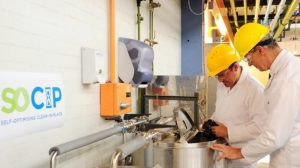
Source: (University of Nottingham SOCIP, 2016)
WIZATA
WIZATA in Luxembourg adds a key element to Payne’s list. Along with Sorting Food, Improving Cleaning Processing, Supply Chain Management and Growing Better Food, they add emphasis to Food Safety Compliance. (WIZATA, 2023) Safety is the top priority for all food processing businesses. All employees and workers who come in direct touch with food have to wear a proper costume and comply with safety standards. Tracking hundreds of employees and making sure that everyone follows the rules is easier said than done. AI-enabled cameras can monitor all workers and notify managers in case a rule is broken. The AI can quickly identify safety issues such as not wearing proper food protection gear or not complying with the rules. The AI can monitor production in real-time and send warnings directly to workers or their managers. (WIZATA, 2023)
AI and RESTURANTS
Escoffier.edu teaches courses in restaurant management. Part of their culinary, pastry and courses for restaurant discipline presents students with a seminar in how AI is changing restaurants. Here are the 9 ways that AI is improving restaurant efficiency:
- Personalized menu recommendations for guests
- Permitting management to make predictive analytics for smarter forecasting
- Chatbots to answer questions, take orders, and set reservations
- Improved cost tracking and menu pricing
- AI-integrated inventory & purchasing to save time
- Robotic food delivery
- More efficient food production
- Developing a stronger and safer supply chain
- Predicting Consumer Response to new products. (escoffier.edu, 2023)
INDIA and ETHIOPIA
In an extensive Indian and Ethiopian joint university research project lead by Dr. Indrajeet Kumar, AI and ML were reviewed in Opportunities of Artificial Intelligence and Machine Learning in the Food Industry. (Kumar, Rawat, Mohd, & Husain, 2021)[14][15]
Their findings for AI and ML in the food industry are consistent with all the OSI addressed factors identified/discussed elsewhere in this chapter. See Figures 4-5, 4-6, 4-7, 4-8, and 4-9 for image summaries of Dr. Kumar’s team findings.
Figure 4-5 shows the roles that AI plays in the food industry:
Food Security management
- Image processing and recognition technologies
- Fertilizer management
- Food inspection and grading
- Robots for warehouse functions
- Food security through information sharing
Food Quality management
- Food quality
- Modeling
- ML for increased productivity
- Pesticide management
Figure 4-6 shows AI / ML important applications taken from food processing and handling industry:
- Products sorting and packaging
- Personal health sanitation
- Customer interactions and decisions
- Equipment cleaning and maintenance
- New products
- Demand-supply chain management
Figure 4-7 shows how AI is used for data analysis in the food industry:
- Introducing new recipes
- Food delivery
- Customer satisfaction
Figure 4-8 shows ML applications in the restaurant business:
- Food vending terminals
- Customer feedback
- Food delivery
- Revenue prediction
- Online restaurant search engine
- Voice assistants
- Self-ordering kiosk system
- Robotics
Figure 4-9 shows two key AI uses in food safety:
- NGS and electric noses [16]
- Food waste management
Next-Generation Sequencing and Electric Noses
The two most promising inventions in the food industry are next-generation sequencing (NGS) and electric noses (ENs). NGS is replacing the DNA approach in the food security region very quickly. The introduction of AI-based automated systems and workflows helped formulate data acquisition and laboratory trials much quicker and more accurately. NGS can find hazardous inclination very quickly and efficiently. It can also prevent the infection epidemics before the impairment of an ample amount of people. ENs are the surrogate for a person muzzle in fabrication surroundings. Some sensors are placed that can precisely identify a diversity of smells. These sensors just sense the smell around the surroundings, and sensed data are transferred to a data center where ML algorithms access these data (Fedorova, Darbasov, & Okhlopkov, 2020) (Yu, Lin, & Wu, 2020). According to the decision made by the ML-based system, an alarm signal is transferred to the manufacturing units. EN can be the upcoming future of food products safety. (Kumar, Rawat, Mohd, & Husain, 2021) However, they did present clarifications of interest on smart farming (SF) technologies.
AI in SF has some important applications such as soil monitoring, robot cropping, and predictive analysis.
Figure 4-5 Role of AI in the Food Industry
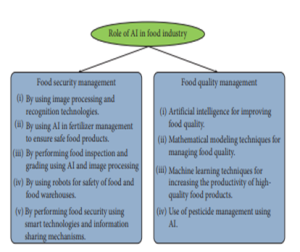
Source: Adapted from Figure 1, p2 in (Kumar, Rawat, Mohd, & Husain, 2021)
Figure 4-6 Important Applications Taken From Food Processing And Handling Industry
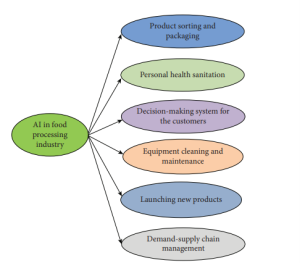
Source: Adapted from Figure 4, p4 in (Kumar, Rawat, Mohd, & Husain, 2021)
Figure 4-7 Data Analysis in the Food Industry
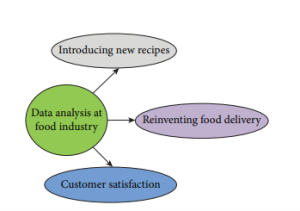
Source: Adapted from Figure 5, p6 in (Kumar, Rawat, Mohd, & Husain, 2021)
Figure 4-8 ML Application In The Restaurant Business
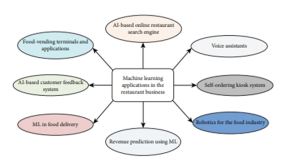
Source: Adapted from Figure 6, p6 in (Kumar, Rawat, Mohd, & Husain, 2021)
Figure 4-9 AI in Food Safety
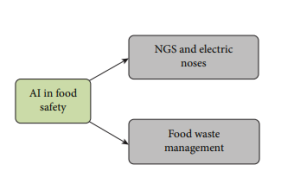
Source: Adapted from Figure 7, p8 in (Kumar, Rawat, Mohd, & Husain, 2021)
SOIL MONITORING (SM)
Under the AI-based system, computer vision and deep-learning algorithm is particularly important and used to investigate the sequence of information or data received by the AI-based agents to trace the progress of crop and soil health. Computerized systems are used to make available clients with a sagacity[17] of their soil’s strengths and weaknesses. The prime objective behind the building of the developed system is to identify defective crops and identify the probable approach for healthy crop development. (Kumar, Rawat, Mohd, & Husain, 2021)
Companies are taking advantage of agriculture AI and aerial technology (Drones / UAS) to keep an eye on crop health. The company’s primary reason is to decrease the costs and improve crop growth. Users preprogram the drone’s route and then integrate with the device. After that, the computer vision will record some pictures that will be used for examination purposes. (Kumar, Rawat, Mohd, & Husain, 2021)
IoT plays an important role in decision on crop and soil monitoring (Raut, Varma, Mulla, & Pawar, 2018). SM with IoT is the application of AI that supports farmers and food industries to capitalize on their economy, diminish the chances of ailment, and optimize uses of available assets. In these, sensors are deployed to sense the temperature of the soil, amount of nitrogen, phosphorus, and potassium (NPK) in soil, moisture level, the content of water, potential in soil, amount of photosynthetic radiation, and oxygen level in soil (Bhattacharyya, Sarkar, Sarkar, Sinha, & Chanda, 2020). Collected data from the various sensors [Table 4-1]are forwarded to the cloud for action. The outcome of the analysis, visualization of received data, is helpful in resource use. The identification of the behavior of the system requires identifying the trends of soil and making the decisions to maximum crop yield and excellent products. (Raut, Varma, Mulla, & Pawar, 2018) (Bhattacharyya, Sarkar, Sarkar, Sinha, & Chanda, 2020). Agriculture based IoT is called smart agriculture. IoT-based food industry is called the smart food industry. (Kumar, Rawat, Mohd, & Husain, 2021)
ROBOCROP
Robocrop is an AI-based robotic system that advances the yielding process by maximizing usefulness and uniformity. It conducts line up crop tools accurately and at a high rate. The food industry product shrubbery forward of the system is monitored by a high-resolution and precise system. The captured image is processed by a high-performing workstation to attend the maximum attentiveness of green band pixels relating to the crop line. Due to the outsized region captured by the input devices and the numerous processing line, an outstanding typical crop Center-line tracking is accomplished (Machleb, Peteinatos, Kollenda, And´ujar, & Gerhards, 2020). It evaluates the resultant image to a ground truth gridiron pattern with the crop line area. The obtained information is then employed to align the instruments in the row via a hydraulic-based shift. The pattern-based attribute builds the system healthy besides backdrop pick over infestations. It improves the performance and production rate just because of multicameras and multiple sensors. (Kumar, Rawat, Mohd, & Husain, 2021) See example in Figure 4-10.
Dr. Kumar describes several advanced Robocrop systems, including dual arm systems for fruit harvesting; robotic weeding systems; robot image systems for identifying plant growth; and adaptive robot chassis (ARC) for sorting strawberry flowers. (Kumar, Rawat, Mohd, & Husain, 2021)
Figure 4-10 Robocrop picking crops
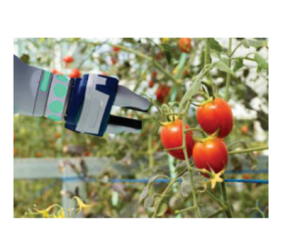
Source: Adapted from Figure 3, p4 in(Kumar, Rawat, Mohd, & Husain, 2021)
“The performance of the Robocrop completely depends on input image features. If the input image contains more dominant features, then it shows outstanding results. In every sample of an input image, the crop must present more shrubbery than the wildflower and the crop shrubbery should be near to the mean of the RGB color band. A typical Robocrop system consists of a Robocrop console part, a hydraulic-based shaft, a three-point linkage frame, a high-definition camera, various types of speed sensors, an ADC adapter, and infrastructure.” (Machleb, Peteinatos, Kollenda, And´ujar, & Gerhards, 2020) See Figure 4-10.
PREDICTIVE ANALYTICS
Learning models are developed to trail and forecast various environmental effects on crop yield such as weather changes. For this, ML algorithms account for a significant role. ML algorithms in association with the satellites investigate crop sustainability, predict the weather, and assess farms to know about the existence of pests and diseases. ML models are exceptionally good at delivering high standard data or information that is perpetually updated at a quick rate. The data sources such as precipitation, wind speed, solar radiation, and temperature along with historical values are important for predictive analysis. The obtained analysis accounts for an important role for adequate scheduling and crop selection for particular agricultural land (Imran, Ahmad, & Kim, 2020).
Table 4-1 Sensors and Types of Measures considered by the Respective Sensors
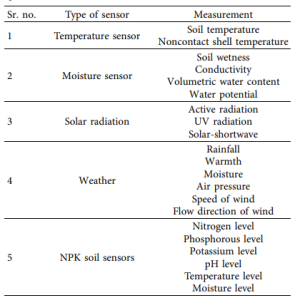
Source: Adapted from Table 1, p3 in (Kumar, Rawat, Mohd, & Husain, 2021)
INTELLIGENT AI AND AGRICULTURE INTERSECTION
In Section III of (Nichols R. K., et al., 2022) our Hope was to improve the global food supply by as much as 1-2%.[18] Dr Zheng in his book (Zheng, 2023) focuses on five areas of research and presents case studies. These are:
- AI – and its role in agriculture and its potential to feed the world,
2. Agriculture Technology,
3. Intelligent Technologies,
4. Food Security, and
5. Sustainability.
Agriculture is a critical industry that plays a vital role in ensuring food security and sustainability. The agriculture sector faces numerous challenges such as climate change, limited resources, and growing demand for food. Artificial intelligence (AI) has emerged as a promising tool to address these challenges by providing intelligent solutions to optimize agricultural practices. (Zheng, 2023)
Dr Zheng states that “machine learning techniques have numerous applications in agriculture, including:” (Zheng, 2023)
Crop-yield prediction: ML algorithms can analyze historical weather data, soil moisture levels and content, to predict crop yields and optimize inputs.
Pest Management: ML can be used to develop predicative models for pest outbreaks, enabling farmers to take preventive measures before damage occurs.
Soil Analysis: ML algorithms analyze the soil samples, identify nutrient deficiencies, and recommend fertilization strategies.
Livestock Monitoring: ML algorithms can monitor animal behavior and health data, allowing farmers to detect early signs of disease or distress. ML is also used in monitoring global migration patterns.
BIO-THREATS TO AGRICULTURE FROM SPACE [19]
For every good there is an opposing evil. The first sections addressed the good side of IA technology to improve crop yields and to endure the Hope of our team to feed the global population. But there is evil too in the form of Bio-Threats to the planet’s agricultural resources. These must be addressed and the threats they provide must be countered.
Publicly available scientific literature about Agroterrorism, biological crimes, and biological warfare targeting livestock and poultry dates back over 100 years. Copious research reports, peer reviews, books, and studies characterizing bioterrorism risks, threats, impact, and detection methods for/to plant ecosystems and the US economy. They have been published as OSI. (Nichols R. K., et al., 2022) (Nichols, et al., 2021) Similarly, research reports, papers, and special government studies have been completed detailing effective plant-advanced bioterrorism countermeasures. These are CLASSIFIED and not OSI.
Bio-threats to agricultural resources are commonly natural. However, rival governments, terrorists, and rogue actors can target critical agricultural infrastructure. The deliberate introduction of an animal or plant disease to generate fear, cause economic losses, and/or undermine stability is known as Agroterrorism,[20] a subset of bioterrorism. [21] (O.S. Cupp, 2004)
Terrorist groups may be motivated to attack plants, animals, or agricultural products to attract attention to a cause, incite fear, disrupt society, or demonstrate a capability to exact political concessions. Others may be prompted by motives such as economic interest, sabotage, or revenge (Ban, 2000). In the event of an agroterrorism attack, keeping the biological incursion from inflicting significant damage to human health and the economy will depend heavily on quick alerts for farmers and disease specialists. We have seen (supra) that these can be addressed using AI and sensors.
Currently, satellite and sensor technologies are revolutionizing crop and livestock disease detection. These technologies can be used individually or in combination to support agricultural surveillance and communication to assist and mitigate threats on the ground. Satellite imaging detects the distinct environmental conditions that may serve as a refuge for the disease-carrying animals. Electromagnetic spectra also provide useful information to make decisions regarding plant physiological stress. In a captured image, plant disease is identified by observing the physiological disturbances caused by foliar reflectance in a near-infrared portion of the spectrum. (S. Sincavage, 2022)
DISEASES HAVE A SIGNIFICANT NEGATIVE IMPACT ON AGRICULTURAL PRODUCTIVITY
The burden of agriculture on endemic and naturally imported epidemic diseases is high. It confirms the capacity of animal and plant diseases to cause economic harm. The United States is free of many significant global livestock diseases because of effective surveillance of herds and imports and aggressive eradication campaigns. (Howard, 2013) In general, losses from animal disease account for 17% of the production costs of animal products in the developed world and twice that amount in the developing world.
The cost of crop diseases to the US economy has been estimated to be more than $30 billion / year. The costs include reducing quantity (bushels/acre) and quality (blemished fruit, toxins in grain) yield, short-term control costs, pesticides, and long-term management and harvesting. (Howard, 2013)
WHAT ARE THE AGRICULTURE, LIVESTOCK, AND COMPANION ANIMAL WEAPONS?
The Animal and Plant Health Inspection Service (APHIS), the US Department of Agriculture (USDA) and the Center for Food Security and Public Health (CFSPH) have developed some serious charts about Agriculture and Zoonotic Bioterrorism. Figures 4-11 to 4-18 portray the threats that must be considered in every risk assessment to develop detection, mitigation, and recovery countermeasures. (Nichols, et al., 2021) (S. Sincavage, 2022)
POTENTIAL TARGETS OF AGRICULTURAL BIOTERRORISM
There are five potential targets of agricultural bioterrorism: field crops; farm animals; food items in the processing or distribution chain; market-ready foods at the wholesale or retail level; and agricultural facilities, including processing plants, storage facilities, wholesale and retail food outlets, elements of the transportation infrastructure, and research laboratories. (Nichols & Carter, 2022) (Parker, 2002) (Wilson, 2000) (Bipartisan Committee on Biodefense, 2022) (Carus, 2015) (S. Sincavage, 2022)
Developing a consensus for a list of the major bioterrorist threats and action items is the priority in protecting crops and animals. Such a list is necessary to guide the development of surveillance plans, diagnostic tests, and response plans for best containing and eradicating an introduced pathogen. Here is one from the Bipartisan Committee on Biodefense: (Bipartisan Committee on Biodefense, 2022)
■ direct losses of agriculture commodities to diseases
■ costs of diagnosis and surveillance
■ required the destruction of contaminated crops and animals to contain the disease
■ costs of disposal of mortalities and carcasses
■ damage to consumer and public confidence
■ need for long-term quarantine of infected areas
■ losses due to export and trade restrictions
■ disruption of commodity markets.
CONTAINMENT, ERADICATION & CONTROL
Introducing exotic pathogens that cause highly contagious animal or plant diseases may elicit rapid and aggressive attempts to contain and eradicate them. These measures cause more economic damage in the short term than the disease itself. Cost may not be the primary factor if the infectious disease becomes endemic. (Howard, 2013)
Containment and eradication of exotic animal diseases are commonly done by culling the potentially exposed animal to break the chain of transmission. (N.M. Ferguson, 2001) Many animal diseases (potential bioterrorist threats) are caused by viruses, for which there are limited therapies once the animal is infected. Fungi cause about 75% of plant diseases. These can be controlled with varying degrees of effectiveness by applying fungicides. (Strange, 1993)
Transmission of bacterial and viral crop diseases is difficult to control with chemical pesticides unless insect vectors transmit the diseases. (Madden & et.al., 2000) Because of these difficulties, containment and eradication of bacteriological pathogens depend heavily on quarantining infected areas and removing infected and exposed plants. (Howard, 2013)
AGRICULTURAL BIOTERRORIST ATTACK REQUIRES RELATIVELY LITTLE EXPERTISE OR TECHNOLOGY
One of the reasons that a bioterrorist attack on human populations is difficult is that the development of an effective bioweapon is a technically daunting task. Many bioagents are poorly transmitted to humans requiring large amounts to be disseminated to cause mass casualties. The only way to cause mass damage is to use a respirable aerosol. This is also a danger to the perpetrators. (Howard, 2013) (Nichols & Carter, 2022) (S. Sincavage, 2022)
The same difficulties do not exist for many of the diseases that would affect agricultural bioterrorist weapons. These diseases of animals and crops are highly contagious and spread effectively from the point source. Moreover, humans can safely manage the causative organisms without risk of infection. There is no need for vaccination, special precautions, or prophylactic antibiotic use. (Howard, 2013) (Nichols & Carter, 2022) (S. Sincavage, 2022)
Material to initiate the plant or animal disease outbreak can be produced in small quantities – a few milligrams could be sufficient to initiate multiple outbreaks in widely separated locations. The raw materials can easily be smuggled into the US. They do not even need to be created in a laboratory. (Howard, 2013)
Dissemination requires little experience. Animal virus preparations can be diluted and disseminated with a simple atomizer in close proximity to the animals. Simply exposing a mass of sporulating fungi in the air immediately upward of a target field could be effective for plant diseases. Weather is the only fly in the ointment. One nightmare scenario is the introduction of a pathogen without perpetrators entering the US. Sorghum is planted on both sides of the Southern border, and wheat and barley are along the Canadian – US border. Multiplication of pathogens in the foreign acreage could lead to numbers of spores blowing across the US border and initiating the escalating outbreak. An advantage to the terrorists is that disease surveillance and control programs are less effective/rigorous OCONUS. (Howard, 2013)
Figure 4-11 Animal Disease From Potential Bioterrorist Agents I
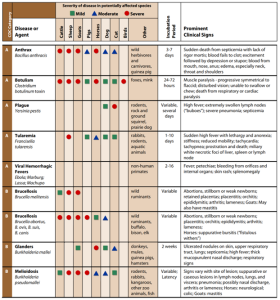
Source: (APHIS & USDA, 2022)
Figure 4-12 Animal Disease From Potential Bioterrorist Agents II
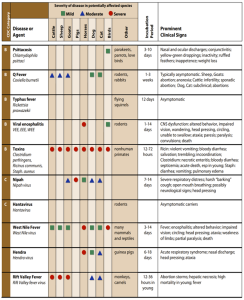
Source: (APHIS & USDA, 2022)
Figure 4-13 Human Disease From Potential from Bioterrorist Agents I
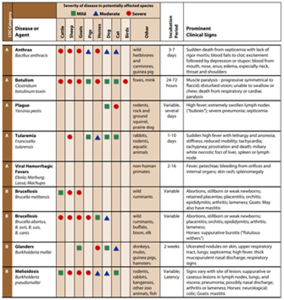
Source: (APHIS & USDA, 2022)
Figure 4-14 Human Disease From Potential from Bioterrorist Agents II
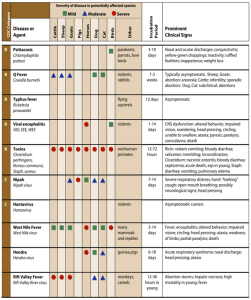
Source: (APHIS & USDA, 2022)
Figure 4-15 USDA High Consequence Foreign Animal Diseases and Pests I
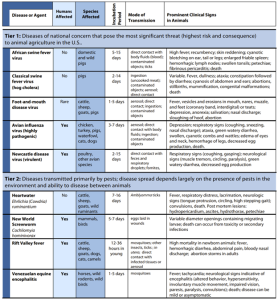
Source: (APHIS & USDA, 2022)
Figure 4-16 USDA High Consequence Foreign Animal Diseases and Pests II
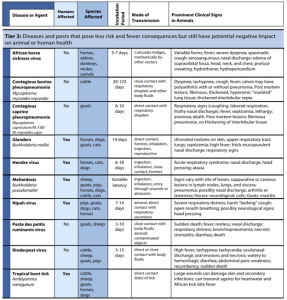
Source: (APHIS & USDA, 2022)
Figure 4-17 Selected Zoonoses of Companion Animals I
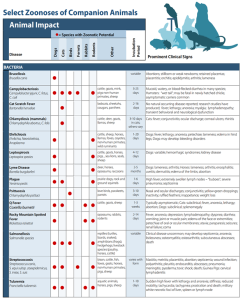
Source: (CFSPH, 2022)
Figure 4-18 Selected Zoonoses of Companion Animals II
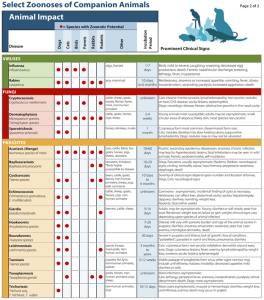
Source: (CFSPH, 2022)
MONITORING OF PLANT PATHOGENS
What is needed?
Answer: A real-time monitoring and communication of abnormalities within livestock and crops using satellite technology. Figure 4-19 shows the operating and planned NASA Earth Fleet through 2023. The Landsat series is particularly useful for agricultural bioterrorism studies. (NASA, 2021)
Figure 4-19 NASA Earth Fleet
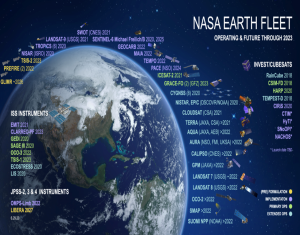
Source: (NASA, 2021)
Figure 4-20 Layers of Agriculture Investigation
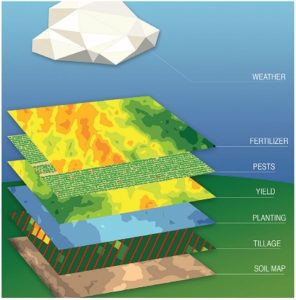
Source: (NASA, 2021)
Figure 4-20 shows the agriculture density map where satellites must penetrate with MASINT [22]sensors. (NASA, 2021)
MASINT
Broadband and multispectral methods rely primarily on visible (VIS) and near-infrared (NIR) reflectance indices, such as normalized difference vegetation index (NDVI). Ability to offer passive monitoring for the disease at scale rather than active sampling. A change in plant behavior could show indications of tampering by bad actors when geological and meteorological variables have been accounted for. (Silva & et.al, 2021)
Remote Sensing (RS) is a technique for obtaining information on an object without physical contact by measuring the electromagnetic energy reflected/backscattered or emitted by the surface of the Earth (Freek D. van der Meer, 2007).
“A significant step forward in earth observation was made with the development of imaging spectrometry. Imaging spectrometers measure reflected solar radiance from the Earth in many narrow spectral bands. Such a spectroscopical imaging system can detect subtle absorption bands in the reflectance spectra and measure the reflectance spectra of various objects with remarkably high accuracy. As a result, imaging spectrometry enables better identification of objects at the Earth’s surface and better quantification of the object properties than can be achieved by traditional earth observation sensors such as Landsat TM and SPOT. ” (Freek D. van der Meer, 2007)
As a noncontact technique, we include in the definition of RS also spectral measurements acquired by portable instruments such as handheld spectroradiometers (also called proximal sensing). These measurements are processed and analyzed to retrieve information on the object observed (i.e., plant health, in this case). RS is an indirect assessment technique, able to monitor vegetation conditions from a distance and evaluate the spatial extent and patterns of vegetation characteristics and plant health in this application. Sensors can be distinguished into active or passive; whether they emit artificial radiation and measure the energy reflected or backscattered (active sensors), the reflected solar radiation, or the emitted thermal radiation (passive sensors). (Martinelli, 2015)
MONITORING OF INVASIVE PLANTS
The effective and regular remote monitoring of agricultural activity is not always possible in developing countries because access to cloud-based geospatial analysis platforms or expensive high-resolution satellite images is not always available. High-resolution satellite images medium-resolution satellite images were used to map the spatial distribution of sickle bush (Dichrostachys cinerea), an archetypal allochthonous invasive plant in Cuba that is becoming impossible to control owing to its rapid growth in areas planted with sugar cane in the Trinidad-Valle de Los Ingenios area (Cuba), a UNESCO World Heritage Site. (E. Moreno, 2021) (S. Sincavage, 2022) details satellite imaging techniques monitoring of invasive plants.
FEEDLOT DENSITY DETECTION
The highly concentrated breeding and rearing practices of our livestock industry make it a vulnerable target for terrorists because diseases could spread rapidly and be difficult to contain. For example, 80 and 90 percent of grain-fed beef cattle production is concentrated in less than 5 percent of the nation’s feedlots. Therefore, deliberately introducing a highly contagious animal disease in a single feedlot could have serious economic consequences. (epidemiology) (Agroterrorism: What Is the Threat and What Can Be Done About It?, 2004)
There is a concern about creating transgenic plant pathogens, pests, or weeds resistant to conventional control methods. This prospect has already been realized through developing a genetically mutant superweed, resistant to current herbicides. The superweed was designed to “attack corporate monoculture” and target genetically engineered crops. (Parker, 2002)
According to Plant Health Inspection Service (APHIS), Earth Observation Epidemiology, or tele-epidemiology, is one of the most promising technologies to monitor feedlot density and diseases. Satellite imaging detects the distinct environmental conditions that may serve as a refuge for the disease-carrying animals. Electromagnetic spectra also provide useful information to make decisions regarding plant physiological stress. (Martinelli, 2015) (APHIS & USDA, 2022)
CONCLUSIONS
Global agriculture / farming are converting to using AI. This translates directly into the global food growth, production and delivery to consumers. The food industry is using the basic level of artificial intelligence. Every day the role of AI is becoming vital due to its capability to escalate hygiene, food protection, and waste management system. AI is going to transform the food processing industry because it has so much potential to generate reasonable and healthier productivity for clients and employees. Employment of AI and ML in food production and eatery businesses is already taking business to a new level by minimizing human mistakes in manufacturing. AI enables low costs for packing as well as conveyance, increment in customer pleasing, rapid services, voice searching, and more personalized orders. The impact of AI in this sector is global.
However, despite the US’s best efforts, the US will continue to be vulnerable to deliberate introductions of exotic plant and animal diseases by terrorist groups.[23] The vulnerability to agricultural biological attack is a consequence of intrinsically low security of agricultural targets, the technical ease of engagement, and the large economic repercussions of even small outbreaks.
The good news is that the US is aggressively stepping up its ISR efforts via satellite. Satellite intelligence on agricultural and cattle feeding zones reduces the risks of successful attacks.[24]
REFERENCES
87-of-us-agriculture-businesses-are-currently-using-ai. (2021, December 12). Retrieved from www.agrinews-pubs.com/: https://www.agrinews-pubs.com/news/science/2021/12/07/87-of-us-agriculture-businesses-are-currently-using-ai/
Agroterrorism: What Is the Threat and What Can Be Done About It? (2004). Retrieved from https://www.rand.org/: https://www.rand.org/pubs/research_briefs/RB7565.html
Allied Market Research. (2023, March ). internet-of-things-iot-in-agriculture-market. Retrieved from www.alliedmarketresearch.com/: https://www.alliedmarketresearch.com/internet-of-things-iot-in-agriculture-market
APHIS & USDA. (2022). wallchart-animal-disease-from-potential-bioterrorist-agents. Retrieved from https://www.cfsph.iastate.edu: https://www.cfsph.iastate.edu/pdf/wallchart-animal-disease-from-potential-bioterrorist-agents
Ban, J. (2000, June). Agricultural Biological Warfare: An Overview. Retrieved from https://www.ojp.gov/ncjrs: https://www.ojp.gov/ncjrs/virtual-library/abstracts/agricultural-biological-warfare-overview
Bazzell, M. (2021). Open Source Intelligence Techniques: Resources for Searching and Analyzing Online Information, 8th edition. Bazzell.
Bhattacharyya, S., Sarkar, P., Sarkar, S., Sinha, A., & Chanda, &. S. (2020). Prototype model for controlling of soil moisture and ph. in smart farming system. Computational Advancement in Communication Circuits and Systems, pp. pp. 405–411, Springer.
Bipartisan Committee on Biodefense. (2022, June). defense-of-animal-agriculture/. Retrieved from https://biodefensecommission.org: https://biodefensecommission.org/reports/defense-of-animal-agriculture/
Carus, W. (2015, Aug 10). The History of Biological Weapons Use: What We Know and What We Don’t. Health security, pp. 13.4 (2015): 219-255. Retrieved from https://www.liebertpub.com/: https://www.liebertpub.com/doi/10.1089/hs.2014.0092
CFSPH. (2022). select-zoonotic-diseases-of-companion-animals-wallchart/. Retrieved from https://www.cfsph.iastate.edu: https://www.cfsph.iastate.edu/product/select-zoonotic-diseases-of-companion-animals-wallchart/
Chen, B., & et.al. (2019, May). Automatic mapping of planting year for tree crops with Landsat satellite time series stacks. Retrieved from https://www.sciencedirect.com: https://www.sciencedirect.com/science/article/abs/pii/S0924271619300802
Columbus, L. (2021, Feburary 17). 10-ways-ai-has-the-potential-to-improve-agriculture-in-2021. Retrieved from www.forbes.com/: https://www.forbes.com/sites/louiscolumbus/2021/02/17/10-ways-ai-has-the-potential-to-improve-agriculture-in-2021/?sh=15d08c507f3b
Definition of Artificial Intelligence . (2023). https://www.merriam-webster.com/dictionary/artificial%20intelligence.
Dictionary.com. (2023, 6 27). Sagacity Definition. Retrieved from www.dictionary.com: www.dictionary.com
Moreno, e. (2021, Sept 29). Affordable Use of Satellite Imagery in Agriculture and Development Projects: Assessing the Spatial Distribution of Invasive Weeds in the UNESCO-Protected Areas of Cuba. Retrieved from https://www.mdpi.com: https://www.mdpi.com/2077-0472/11/11/1057
escoffier.edu. (2023). 9 Ways Artificial Intelligence is Changing the Food Industry. Retrieved from www.escoffier.edu: https://www.escoffier.edu/blog/world-food-drink/how-artificial-intelligence-is-changing-the-food-industry/
Fedorova, E., Darbasov, V., & Okhlopkov, &. M. (2020). The role of agricultural economists in study on problems related to regional food safety. E3S Web of Conferences, pp. vol. 176, p. 5011.
Freek D. van der Meer, S. d. (2007, July 27). Imaging Spectrometry: Basic Principles and Prospective Applications. Retrieved from https://books.google.com/: https://books.google.com/books/about/Imaging_Spectrometry.html?id=XDBRCpQy64UC
Howard, J. J. (2013). Weapons of Mass Destruction and Terrorism. NYC: McGraw Hill.
Imran, S., Ahmad, S., & Kim, &. D. (2020). Quantum GIS based descriptive and predictive data analysis for effective planning of waste management. IEEE Access, pp. vol. 8, pp. 46193–46205.
Integrate UAV Technology with Yield Maps. (2023). Retrieved from www.petersonfarmsseed.com: https://www.petersonfarmsseed.com/3352-2/
Kumar, I., Rawat, J., Mohd, N., & Husain, &. S. (2021, July 12). Opportunities of Artificial Intelligence and Machine Learning in the Food Industry. Retrieved from https://www.hindawi.com/journals/: https://www.hindawi.com/journals/jfq/2021/4535567/
Larson, H. (2022). Humanitarian Use of Space Technologies to Improve Global Food Supply & Cattle Management. In R. K. Nichols, C. M. Carter, J.-P. Hood, M. J. Jackson, S. M. Joseph, H. Larson, . . . Sincavage, SPACE SYSTEMS: EMERGING TECHNOLOGIES AND OPERATIONS (pp. 545-589). Manhattan, KS: NPP eBooks. 47.
Machleb, J., Peteinatos, G. G., Kollenda, B. L., And´ujar, D., & Gerhards, &. R. (2020). Sensor-based mechanical weed control: present state and prospects. pp. vol. 176, Article ID 105638.
Madden, L., & et.al. (2000). A theoretical assessment of the effects of vector-virus transmission mechanism on plant virus disease epidemics. Phytopathology, pp. 90:576-594.
Martinelli, F. e. (2015). Advanced methods of plant disease detection. A review. Retrieved from https://link.springer.com/article/10.1007/s13593-014-0246-1: https://link.springer.com/article/10.1007/s13593-014-0246-1
Mumm, H. C. (2022). Drones and Precision Agricultural Mapping. In R. K. Nichols, C. M. Carter, J.-P. Hood, M. J. Jackson, S. M. Joseph, H. Larson, . . . Sincavage, Space Systems: Emerging Technologies and Operations (pp. 472-507). Manhattan, KS: NPP eBooks. 47.
N.M. Ferguson, D. C. (2001). Transmission Intensity and impact of control policies on the foot-and-mouth epidemic in Great Britain. Nature, pp. 413: 542-548.
NASA. (2021, April). NASA_satellite_fleet.jpg. Retrieved from https://gpm.nasa.gov/: https://gpm.nasa.gov/sites/default/files/2021-04/NASA_satellite_fleet.jpg
Nichols, & Carter, H. J. (2022). Drone Delivery of CBNRECy – DEW Weapons: Emerging Threats of Mini-Weapons of Mass Destruction and Disruption (WMDD). Manhattan, KS: New Prairie Press #46.
Nichols, R. K. (2002). Wireless security : models, threats, and solutions .
Nichols, R. K. (2020). Unmanned Vehicle Systems and Operation on Air, Sea, and Land (Vol. IV). Manhattan: New Prairie Press.
Nichols, R. K. (2022). Section 3.0 Cyber Risk Assessments – Ryan-Nichols Equations.
Nichols, R. K., Carter, C. M., Hood, J.-P., Jackson, M. J., Joseph, S. M., Larson, H., . . . S. (2022). Space Systems: Emerging Technologies and Operations (2022). Manhattan, KS: https://newprairiepress.org/ebooks/47/.
Nichols, R. K., Sincavage, S., Mumm, H., Lonstein, W., Carter, C., Hood, J., . . . & Shields, B. (2021). Disruptive Technologies With Applications In Airline, Marine, Defense Industries. Manhattan, KS: New Prairie Press, #38.
O.S. Cupp, D. W. (2004). Agroterrorism in the U.S.: key security challenge for the 21st century. Biosecurity and Bioterrorism: Biodefense Strategy, Practice and Science 2, 97–105., pp. 2, 97–105. Retrieved from https://pubmed.ncbi.nlm.nih.gov/15225403/: https://pubmed.ncbi.nlm.nih.gov/15225403/
Parker, H. S. (2002). McNair_65_agriculturalbioterrorism.pdf. Retrieved from https://www.files.ethz.ch: https://www.files.ethz.ch/isn/10897/McNair_65_agriculturalbioterrorism.pdf
Payne, J. (2021, Sep 28). artificial-intelligence-in-food-industry. Retrieved from https://www.aptean.com/: https://www.aptean.com/en-US/insights/blog/artificial-intelligence-in-food-industry
Raut, R., Varma, H., Mulla, C., & Pawar, &. V. (2018). “Soil monitoring, fertigation, and irrigation system using IoT for agricultural application. Intelligent Communication and Computational Technologies, pp. pp. 67–73, Springer, Singapore.
Ryan, J. J. (2022). Civilian use of Space for Environmental, Wildlife Tracking, & Fire Risk Zone ID. In R. K. Nichols, C. M. Carter, J.-P. Hood, M. J. Jackson, S. M. Joseph, H. Larson, . . . Sincavage, Space Systems: Emerging Technologies and Operations (pp. 508-544). Manhattan, KS: https://newprairiepress.org/ebooks/47/.
Sincavage, C. C. (2022). Bio-threats to Agriculture-Solutions from Space. In R. K. Nichols, C. M. Carter, J.-P. Hood, M. J. Jackson, S. M. Joseph, H. Larson, . . . Sincavage, Space Systems: Emerging Technologies and Operations (pp. 408-431). Manhattan, KS: NPP eBooks #47.
Silva, G., & et.al. (2021, May 20). Plant pest surveillance: from satellites to molecules. Emerg Top Life Sci., pp. 5(2):275-287. doi:10.1042/ETLS20200300. PMID: 33720345; PMCID: PMC8166340.
Strange, R. (1993). Plant Disease Control. London: Chapman and Hall.
Teske A. L., G. C. (2019). Optimized dispensing of predatory mites by multirotor UAVs in wind: a distribution pattern modelling approach for precision pest management. . Biosyst. Eng. , pp. 187: 226–238. Retrieved from Teske A. L., G. Chen, C. Nansen, and Z. Kong. 2019. Optimized dispensing of predatory mites by multirotor UAVs in wind: a distribution pattern modelling approach for precision pest management. Biosyst. Eng. 187: 226–238.
Top 5 2023 Agriculture Trends to Watch. (2023). Retrieved from www.agmatix.com/: https://www.agmatix.com/blog/top-5-2023-agriculture-trends-to-watch/
University of Nottingham SOCIP. (2016, 9 13). artificially-intelligent-food-gbp100m-year. Retrieved from https://phys.org : https://phys.org › news › 2016-09-artificially-intelligent-food-gbp100m-year.pdf
University of Sydney. (2017). Digital Farmland . Retrieved from http://confluence.acfr.usyd.edu.au/display/AGPub/Our+Robots: http://confluence.acfr.usyd.edu.au/display/AGPub/Our+Robots
University of Sydney. (2022, 11 2). Can-robots-and-ai-help-address-the-world-s-food-security-issues. Retrieved from https://www.sydney.edu.au/news-opinion/: https://www.sydney.edu.au/news-opinion/news/2022/11/02/can-robots-and-ai-help-address-the-world-s-food-security-issues-.html
Wiki. (2022). Measurement_and_signature_intelligence (MASINT) definition. Retrieved from https://en.wikipedia.org: https://en.wikipedia.org/wiki/Measurement_and_signature_intelligence
Wiki. (2022, Aug 26). Tele-epidemiology. Retrieved from https://en.wikipedia.org: https://en.wikipedia.org/wiki/Tele-epidemiology
Wilson, T. M. (2000, Sept). Agroterrorism, Biological Crimes, and Biowarfare Targeting Animal Agriculture: The Clinical, Pathologic, Diagnostic, and Epidemiologic Features of Some Important Animal Diseases. Emerging diseases of animals, 23-57. Retrieved from https://www.sciencedirect.com: https://www.sciencedirect.com/science/article/abs/pii/S0272271218300222
WIZATA. (2023). how-the-food-industry-can-benefit-from-ai. Retrieved from https://www.wizata.com/: https://www.wizata.com/knowledge-base/how-the-food-industry-can-benefit-from-ai
Yu, X., Lin, Y., & Wu, a. H. (2020). Targeted next-generation sequencing identifies separate causes of hearing loss in one deaf amily and variable clinical manifestations for the p.R161C Mutation in SOX10. Neural Plasticity, pp. vol. 2020, pp. 1–8,.
Zheng, M. (2023). Artificial Intelligence and Agriculture: How Intelligent Technologies Can Help Feed the World. Wuhan, China: zhengpublishing.com .
ENDNOTES
[1] Quote by Managing editor Prof. Randall K. Nichols, DTM.
[2] Think Robin Williams in the 1999 movie Bicentennial Man
[3] In the authors view, this is an extreme position by Dr. Zheng and the authors do not agree with the totality of the statement. However, they agree with effects of naturally caused disasters and force majeure. “Environmental footprints” is a tricky phrase. To the extent that man can provide sustainable practices involving naturally caused climate events, we concur. However, the current use of climate hysteria with penalties on the life sustaining element of carbon (or carbon credits) is a fraud and misuse of real scientific information for political purposes. We agree with Dr Zheng that this is a global concern because the hysteria has reached the level of almost political intrigue and power adjustment. For those who need further clarification and perhaps a change of view see: (Wrightstone, 2017) and the author’s definitive position in: (R.K. Nichols, 2021)
[4] Author opinion.
[5] Louis Columbus’s full article can be heard at: https://www.forbes.com/sites/louiscolumbus/2021/02/17/10-ways-ai-has-the-potential-to-improve-agriculture-in-2021/?sh=15d08c507f3b (voice)
[6] CAGR = compound annual growth rate
[7] Covered superbly by Dr Larson in (Larson, 2022)
[8] The author owns a small farm in Arkansas. Deer are the bane of our soybeans and wheat.
[9] Authors remarks at end based on SME experience. In one SCIF and TOC installation I managed, every door that was opened or closed gave alarms at 24/7. Considering the TOC and SCIF were part of a cybersecurity educational building with three specialized labs, and teaching facilities for about 800 students, the traffic hourly was beyond unreasonable to be watching nine screens. I can imagine watching empty fields at night using IR when 50 or so deer cross the acreage. Filtering the systems for time-based and animal-based temperature changes is required. ML systems can be trained to id people, vehicles, or animals.
[10] KSU has been pioneering / researching this discipline for a decade. They are the leader of the pack.
[11] KSU has installed multiple weather stations around the state to enhance drone research on agricultural mapping operations.
[12] Primarily for small farmers.
[13] “It’s projected that APAC will need to increase food production by up to 77 percent to feed its communities by 2050. Bold steps must be taken to accelerate progress towards addressing the major drivers of food insecurity, malnutrition, and equal access to food – as well as drive smart solutions that give back power to local farmers,” said Professor Sukkarieh. (University of Sydney, 2022)
[14] Author affiliations in order: Graphic Era Hill University, Dehradun, Uttarakhand, India, DIT University, Dehradun, Uttarakhand, India Graphic Era Deemed to be University, Dehradun, Uttarakhand, India, College of Engineering & Technology, Samara University, Semera, Ethiopia
[15] (Kumar, Rawat, Mohd, & Husain, 2021) has 53 excellent references backing up their research.
[16] NGS = Next generation sequencing – replaces DNA approach in the food security region.
[17] Sagacity- foresight, discernment, keen perception, to make good judgements (Dictionary.com, 2023)
[18] This would be a wonderful legacy for the author and the KSU Wildcat Team if even small part of the Hope and “word” got to the right decision-makers in every country. The world population is growing – big time. Lots of hungry families. WE would like to improve their lives.
[19] A decent portion of this section has been summarized from our own textbook Chapter 8” Bio-Threats To Agriculture From Space- Solutions From Space (S. Sincavage, 2022). The managing editor deemed the material an excellent counterpoint to the positivity of the first two sections.
[20] Agroterrorism is a subset of bioterrorism and is defined as the deliberate introduction of an animal or plant disease to generate fear, causing economic losses and/or undermining stability. (O.S. Cupp, 2004)
[21] Bioterrorism is the threat or use of biological agents by individuals or groups motivated by political, religious, ecological, or other ideological objectives.
[22] MASINT – Measurement and signature intelligence (MASINT) is a technical branch of intelligence gathering that detect, track, identify or describe the distinctive characteristics (signatures) of fixed or dynamic target sources. This often includes radar, acoustic, nuclear, chemical, and biological intelligence. MASINT is scientific and technical intelligence derived from the analysis of data obtained from sensing instruments to identify any distinctive features associated with the source, emitter, or sender, to facilitate the latter’s measurement and identification. (Wiki, 2022)
[23] Obviously, the US is not only country concerned about this threat. Other countries are addressing the bio-threats in valuable ways and if possible, intelligence should be shared to decrease the global risks. Countries sharing information unfortunately has limitations.
[24] Where there is Good, there is Evil.

